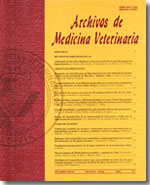Brote de una enfermedad en un plantel de pavos atribuido a enteritis hemorrágica
Conteúdo do artigo principal
Resumo
Para determinar la causa específica de una elevada mortalidad en un plantel de pavos, se recibieron 5 pavos en total, provenientes de tres lotes de 6, 7 y 8 semanas de edad realizándose en ellos necropsia y se recolectó muestras para estudio histopatológico, ultraestructural y bacteriológico.
En la necropsia se observaron lesiones en intestino, el que se encontraba distendido, y con contenido sanguinolento en el lumen. Histopatológicamente se observó una enteritis hemorrágica, hiperemia e infiltrado de células mononucleares en la lámina propia, presentando algunas muestras una lesión necrótica, con presencia de colonias bacterianas.
Los cultivos bacteriológicos mostraron crecimiento de Escherichia coli y en cultivos repetidos tres semanas después en los mismos lotes de pavos se aislo Pasteurella multocida.
El bazo, se observó aumentado de tamaño, con un moteado gris blanquecino alternado con un fondo rojo oscuro, al corte. Histopatológicamente se observó amplias zonas de necrosis en los centros germinales y depleción, e hiperplasia de las células reticulares con presencia de cuerpos de inclusión intranucleares y marginación de la cromatina, correspondiendo ultraestructuralmente a centros de replicación viral, con partículas virales hexagonales de 55-58 nm de diámetro, que según tamaño y forma corresponderían a adenovirus aviar tipo II.

